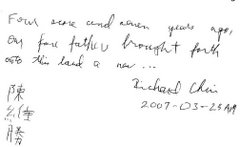Andrea is guest blogging with Richard in covering this year’s National Ataxia Foundation conference in Seattle (or more specifically, Sea-Tac, as the city’s mayor kindly pointed out as he welcomed the participants this morning). Spending the latter portion of my spring break here has been as educational as being in class. The opening lecture, reviewing the genetic basis of ataxia, compacted “3 years worth of cellular biology,” in Dr. Perlman’s words. Dr. Laura Ranum used the apt metaphor of drinking from a fire hydrant to describe the knowledge influx in medical research. At the top of the research agenda is integrating the findings from all these molecular genetic and neuropathological studies into understanding how to treat the various types of ataxia.
Ataxia experts Dr. Ranum, Dr. Harry Orr and Dr. SH Subramony, succinctly discussed upcoming trends in ataxia studies, with basic scientific research evolving into transitional research. Ataxia research has promising new avenues for funding, which is critical for these medical investigations to progress. Despite the woes of the current economic climate, the NIH has received an additional $8.2 billion for clinical and translational research, among other areas of medical interest. So far this year, 9 approved research grants, out of 48 applications processed, will be receiving $484,000 from the NAF. Researchers want to capitalize on the $1 million NIH challenge grants with an unprecedented, accelerated funding approval process; these challenge grant studies should be starting earliest 9/30/09. We’ll be staying tuned for tomorrow’s presentations focusing on these individual experts’ upcoming trials and how ataxia patients can become involved.
The conference has engaged much peer-to-peer interaction and education. Researchers lucidly presented this complex material to the general audience of patients and caregivers, as well as updating their fellow experts about developments in the field. Kudos to Corrie Smith’s presentation on genetic testing for being extremely accessible and thoughtful in considering the complexity of ethical implications involved for all parties. The “Birds of a Feather” breakout sessions were particularly valuable, with each session focusing on a different group affected by ataxia so that caregivers, people with SCA 3, individuals with Friedrich’s, etc. could discuss their experiences with each other. In between workshops and presentations participants were mingling with each other, discussing their experiences with various physical therapies, diet/supplement regimens, drugs and other treatments and recommending what they had found effective.
The accommodations at the Doubletree have generally been accessible: the low-pile carpets are wheelchair-friendly, there are plenty of places to sit along the hallway, and most of the workshops have been on the first floor. The booths outside the main presentation area featured all sorts of useful pamphlets and booklets, local support services for Washington area ataxia patients, and opportunities for attendees to participate in some new studies on the spot. If you’re a conference attendee reading this and have some time tomorrow, please stop by UC Berkeley research coordinator Nola Klemfuss’s experimental set up. She’s conducting non-invasive, physically undemanding studies on visuo-motor coordination and could really use some more folks to participate. Compensation is $20/hour, and participation takes about 1.5 hours. Richard participated in her study and can vouch that it’s interesting.
We look forward to keeping you posted on the latest clinical trials and RNAi research in the next two days.
Friday, March 20, 2009
Subscribe to:
Comments (Atom)


